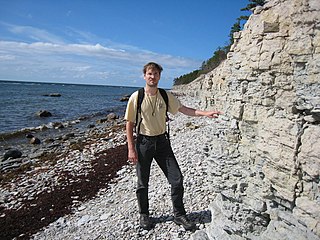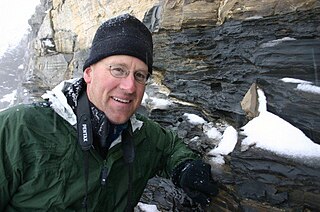
The Silurian is a geologic period and system spanning 24.6 million years from the end of the Ordovician Period, at 443.8 million years ago (Mya), to the beginning of the Devonian Period, 419.2 Mya. The Silurian is the shortest period of the Paleozoic Era. As with other geologic periods, the rock beds that define the period's start and end are well identified, but the exact dates are uncertain by a few million years. The base of the Silurian is set at a series of major Ordovician–Silurian extinction events when up to 60% of marine genera were wiped out.

A Lagerstätte is a sedimentary deposit that exhibits extraordinary fossils with exceptional preservation—sometimes including preserved soft tissues. These formations may have resulted from carcass burial in an anoxic environment with minimal bacteria, thus delaying the decomposition of both gross and fine biological features until long after a durable impression was created in the surrounding matrix. Lagerstätten span geological time from the Neoproterozoic era to the present. Worldwide, some of the best examples of near-perfect fossilization are the Cambrian Maotianshan shales and Burgess Shale, the Ordovician Soom Shale, the Silurian Waukesha Biota, the Devonian Hunsrück Slates and Gogo Formation, the Carboniferous Mazon Creek, the Triassic Madygen Formation, the Jurassic Posidonia Shale and Solnhofen Limestone, the Cretaceous Yixian, Santana, and Agua Nueva formations, the Eocene Green River Formation, the Miocene Foulden Maar and Ashfall Fossil Beds, the Pliocene Gray Fossil Site, the Pleistocene Naracoorte Caves, the La Brea Tar Pits, and the Tanis Fossil Site.

Paleoecology is the study of interactions between organisms and/or interactions between organisms and their environments across geologic timescales. As a discipline, paleoecology interacts with, depends on and informs a variety of fields including paleontology, ecology, climatology and biology.

The Cisuralian is the first series/epoch of the Permian. The Cisuralian was preceded by the Pennsylvanian and followed by the Guadalupian. The Cisuralian Epoch is named after the western slopes of the Ural Mountains in Russia and Kazakhstan and dates between 298.9 ± 0.15 – 272.3 ± 0.5 Mya.
The Andean-Saharan glaciation, also known as the Early Palaeozoic Icehouse, the Early Palaeozoic Ice Age, the Late Ordovician glaciation, the end-Ordovician glaciation, or the Hirnantian glaciation, occurred during the Paleozoic from approximately 460 Ma to around 420 Ma, during the Late Ordovician and the Silurian period. The major glaciation during this period was formerly thought only to consist of the Hirnantian glaciation itself but has now been recognized as a longer, more gradual event, which began as early as the Darriwilian, and possibly even the Floian. Evidence of this glaciation can be seen in places such as Arabia, North Africa, South Africa, Brazil, Peru, Bolivia, Chile, Argentina, and Wyoming. More evidence derived from isotopic data is that during the Late Ordovician, tropical ocean temperatures were about 5 °C cooler than present day; this would have been a major factor that aided in the glaciation process.

The Early Triassic is the first of three epochs of the Triassic Period of the geologic timescale. It spans the time between 251.902 Ma and 247.2 Ma. Rocks from this epoch are collectively known as the Lower Triassic Series, which is a unit in chronostratigraphy.

The late Paleozoic icehouse, also known as the Late Paleozoic Ice Age (LPIA) and formerly known as the Karoo ice age, was an ice age that began in the Late Devonian and ended in the Late Permian, occurring from 360 to 255 million years ago (Mya), and large land-based ice-sheets were then present on Earth's surface. It was the second major icehouse period of the Phanerozoic. It is named after the tillite found in the Karoo Basin of western South Africa, where evidence for the ice age was first clearly identified in the 19th century.

The Nemegt Formation is a geological formation in the Gobi Desert of Mongolia, dating to the Late Cretaceous. The formation consists of river channel sediments and contains fossils of fish, turtles, crocodilians, and a diverse fauna of dinosaurs, including birds.
In the geological timescale, the Ludlow Epoch occurred during the Silurian Period, after the end of the Homerian Age. It is named for the town of Ludlow in Shropshire, England.

The Lystrosaurus Assemblage Zone is a tetrapod assemblage zone or biozone which correlates to the upper Adelaide and lower Tarkastad Subgroups of the Beaufort Group, a fossiliferous and geologically important geological Group of the Karoo Supergroup in South Africa. This biozone has outcrops in the south central Eastern Cape and in the southern and northeastern Free State. The Lystrosaurus Assemblage Zone is one of eight biozones found in the Beaufort Group, and is considered to be Early Triassic in age.

"Proornis" is an extinct genus of basal bird from the Early Cretaceous Gyeongsang Supergroup of northernmost North Korea. Since it was never formally described in a peer-reviewed journal, the genus is considered a nomen nudum. A single species, "Proornis coreae", is known.
The Lau event was the last of three relatively minor mass extinctions during the Silurian period. It had a major effect on the conodont fauna, but barely scathed the graptolites, though they suffered an extinction very shortly thereafter termed the Kozlowskii event that some authors have suggested was coeval with the Lau event and only appears asynchronous due to taphonomic reasons. It coincided with a global low point in sea level caused by glacioeustasy and is closely followed by an excursion in geochemical isotopes in the ensuing late Ludfordian faunal stage and a change in depositional regime.

The Fezouata Formation or Fezouata Shale is a geological formation in Morocco which dates to the Early Ordovician. It was deposited in a marine environment, and is known for its exceptionally preserved fossils, filling an important preservational window beyond the earlier and more common Cambrian Burgess shale-type deposits.
The Steptoean Positive Carbon Isotope Excursion (SPICE) was a geological event which occurred about 495 million years ago near the beginning of the International Furongian Epoch of the Cambrian Period. The SPICE represents an increase in the atmospheric 13C to 12C ratio, known as the δ13C, and lasted for around 2 to 4 million years.
The Bulletin of Geosciences is a peer-reviewed scientific journal publishing original research papers, review articles, and short contributions. It covers all aspects of palaeoenvironmental geology, including palaeontology, stratigraphy, sedimentology, palaeogeography, palaeoecology, palaeoclimatology, geochemistry, mineralogy, geophysics, and related fields.
Francisca Oboh-Ikuenobe is a geologist from Ubiaja in Esan South East Local Government Area of Edo State. She was born August 1962 She specialises in palynology and sedimentology, and is Professor of Geology in the Department of Geosciences and Geological and Petroleum Engineering, and Associate Dean of Academic Affairs in the College of Engineering and Computing, Missouri University of Science and Technology.

Olev Vinn is Estonian paleobiologist and paleontologist.

John Russell Foster is an American paleontologist. Foster has worked with dinosaur remains from the Late Jurassic of the Colorado Plateau and Rocky Mountains, as well as working on Cambrian age trilobite faunas in the southwest region of the American west. He named the crocodyliform trace fossil Hatcherichnus sanjuanensis in 1997 and identified the first known occurrence of the theropod trace fossil Hispanosauropus in North America in 2015.
Celina A. Suarez is an American geologist. She is known for her research on using trace element and stable isotope geochemistry of fossil vertebrates and invertebrates to understand paleoecology, paleoclimatology, and taphonomy of ancient terrestrial ecosystems. She is an associate profession in the Department of Geosciences at the University of Arkansas. The dinosaur Geminiraptor suarezarum is named after Suarez and her twin sister, Marnia Suarez, co-discovers of the site on which it was found.











